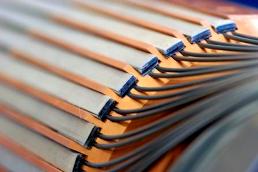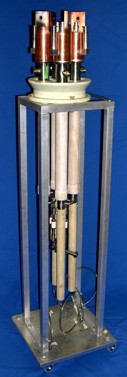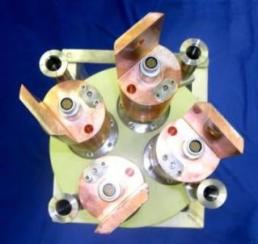|
The powering of the LHC
superconducting magnets will be made via 3250 current leads transporting in total
about 3 MA of current into the “cold-mass” of the LHC machine. They
will be installed in the LHC tunnel, where they will provide the electrical link between the room temperature
power cables and
the cold bus-bars, bringing the current from/to the cryo-magnets.
Among the LHC current leads, 1030 components incorporate a section with HTS
(High Temperature Superconducting) material. Optimized conventional
self-cooled current leads conduct into the liquid helium about 1.1 W/kA. For
the LHC HTS current leads, the use of HTS material allows a reduction of
heat load into the liquid helium by a factor of 10 if compared to
conventional self-cooled leads. The reduction in total cooling power is
about a factor of 3.
Following an intensive R&D
program, which started at CERN in early 1995, devoted to the test of high
current HTS elements,
the Bi-2223 tape with a silver-gold
alloy matrix has been
selected as the most suitable material for the LHC current lead application. The HTS current leads for the LHC machine represent the first application of HTS
material in a large scale accelerator system.
The HTS
current leads are used for circuits operating at ultimate currents comprised
in the range 600
A to13000 A. They are designed as three different types optimized for operating respectively at 600 A,
6000 A and 13000 A. They power the LHC main dipole and quadrupole
magnets, the dipole and quadrupole magnets in the matching sections and
dispersion suppressors and some of the
corrector magnets.
The remaining leads, which are resistive, feed the 60 A and 120 A
electrical circuits of the corrector magnets. They are 2024 in total and
they are designed as three different series: a series of 60 A and 120 A
conduction-cooled leads and a series of 120 A gas-cooled leads. In spite of their important number, these resistive leads transport only about 5 % of
the total current powering the LHC magnet circuits. They are of a special
design which was developed to satisfy the LHC requirements of
flexibility and compactness while having good electrical and thermal performance.
The design of all these LHC leads was made and validated at CERN with the construction and test of
prototype units. Key-issues of the design are the optimization of the
thermal and electrical performance, the compactness and sturdiness of
the components, which are conceived to guarantee continuous operation of the
magnet systems during the LHC lifetime. The final series are being
manufactured in industry and external laboratories on the basis of CERN “build-to-print” designs.
Mandate of
the AT-MEL-CF section
-
Optimization and design of all the current leads, both resistive and
superconducting, powering the LHC magnets;
-
Specification,
procurement, assembly and test of the HTS
material to be integrated in the superconducting current leads;
-
Specification
and procurement of all the current leads powering the LHC superconducting
magnets;
-
Qualification
and test in nominal operating conditions of all
superconducting current leads prior to installation in the LHC cryostats;
-
Specification
and procurement of the electrical ancillaries for the current leads to be installed
and operated in the LHC tunnel.
|

HTS-LTS Electrical joint


13000 A and 600 A HTS current leads

Top view of 600 A HTS current lead assembly |